Las estadísticas de comunicación en el lugar de trabajo muestran que el 86% de los empleados y ejecutivos mencionan la falta de colaboración y comunicación eficaces como las principales causas de las fallas en el lugar de trabajo.
Por otro lado, los equipos que se comunican de manera eficaz pueden aumentar su productividad hasta en un 25%.
Pero eso sólo se aplica a aquellos que han establecido canales de comunicación efectivos. Desafortunadamente, un tercio de los comunicadores afirma estar insatisfecho con los canales que utilizarán en su lugar de trabajo en 2025.
Entonces, ¿cuál es la solución a este enigma de la comunicación? Seguramente la respuesta está en las estadísticas más recientes sobre comunicación en el lugar de trabajo que estamos a punto de presentar.

- El 64% de los líderes empresariales y el 55% de los trabajadores del conocimiento creen que la comunicación efectiva aumenta la productividad del equipo.
- El 63% de las personas cree que el tiempo perdido es una de las peores consecuencias de una mala comunicación.
- El 57% de los empleadores globales indican que la comunicación es la habilidad más deseable que deben tener los reclutantes potenciales.
- El 55% de los reclutantes globales cree que la comunicación verbal es la habilidad de comunicación más importante que un solicitante de empleo debe tener, seguida por las habilidades de presentación (el 47%) y escucha activa (el 36%).
- El 36% de los reclutantes también indica que saber cómo usar las herramientas de comunicación digital y videoconferencias también es una habilidad crucial que deben tener los solicitantes de empleo.
- El 89% de los líderes y el 52% de los trabajadores del conocimiento ya usan las herramientas de la IA generativa para el trabajo.
- El 73% de los trabajadores del conocimiento dice que las herramientas de la IA generativa les ayuda a evitar la falta de comunicación en el trabajo.
Estadísticas sobre por qué la comunicación eficaz es importante en el lugar de trabajo
La comunicación adecuada dentro de un negocio trae varios beneficios para dicho negocio.
Los estudios, informes e investigaciones muestran que la comunicación eficaz en equipo afecta positivamente a los empleados en términos de:
- Productividad,
- Compromiso,
- Retención, y
- Confianza.
Entonces, ¿cuáles son las estadísticas sobre la importancia de la comunicación en el lugar de trabajo? ¡Vamos a averiguar!
Beneficio 1: La comunicación eficaz aumenta la productividad
Podría decirse que uno de los beneficios más importantes de una comunicación eficaz en el lugar de trabajo es que afecta positivamente la productividad de los empleados.
Además de sentirse más conectados con sus colegas, los empleados que se comunican regularmente entre sí son más productivos.
Esto era evidente en un informe de McKinsey, que mostraba que los equipos bien conectados ven un aumento de productividad del 20 al 25%.
Un estudio más reciente del Instituto McKinsey sobre el futuro del trabajo remoto sugiere algo similar. Es decir, los empleados que se sienten incluidos en una comunicación más detallada en el lugar de trabajo tienen casi 5 veces más probabilidades de reportar una mayor productividad.
La información más reciente que tenemos sobre este tema proviene de un informe llamado The State of Business Communication en 2024 realizado por Harris Poll en nombre de Grammarly. Ese estudio muestra que el 64% de 253 líderes empresariales encuestados cree que la comunicación eficaz ha aumentado la productividad de su equipo, y el 55% de los trabajadores del conocimiento está de acuerdo.
Además, el 55% de 1002 trabajadores del conocimiento encuestados afirmaron que la comunicación eficaz aumentó su confianza en el trabajo. Mientras tanto, el 58% de los trabajadores también afirmaron que aumentó su satisfacción laboral.
Sin embargo, debemos reconocer que la comunicación innecesaria también puede perjudicar la productividad, como señala el informe State of the Sector 2024 de Gallagher. En concreto, demasiada comunicación puede ser una barrera para el éxito, según el 19% de los participantes en la encuesta de Gallagher. Pero hablaremos de eso más adelante.
🎓 CONSEJO PRO DE PUMBLE
Podría decirse que la comunicación eficaz es la única forma de aumentar la productividad en entornos de trabajo remoto. Para obtener más información sobre lo que los trabajadores remotos necesitan para prosperar, consulta nuestras estadísticas de trabajo remoto:
Beneficio 2: La comunicación eficaz mejora el compromiso
Según el informe de Gallup de 2024 State of the Global Workplace, los empleados desmotivados le cuestan al mundo unos increíbles 8,9 billones de dólares en pérdida de productividad.
Aunque los datos de Gallup han mostrado cierta mejora, con cifras de compromiso de los empleados que pasaron del 20% en 2020 al 23% en 2022, el porcentaje se estancó en 2023, por lo menos en las organizaciones globales.
Curiosamente, las últimas noticias de Gallup muestran que el compromiso de los empleados está en ligero descenso en las empresas estadounidenses (donde el compromiso ahora es del 31%) así como las organizaciones con mejores prácticas (que cuentan con tarifas de compromiso del 70%), aunque estos números son aún así mejores que el promedio global.
Según un resumen de tendencias clave en el compromiso de los empleados, parece que esta caída en el compromiso se puede resolver:
- Aclarando las expectativas (sólo el 46% de los empleados saben quće se espera de ellos en el trabajo),
- Mostrando la empatía y preocupación (sólo el 39% de los empleados pueden afirmar que alguien se preocupa por ellos),
- Centrándose en el desarrollo de los empleados (sólo el 30% de los empleados tienen a alguien en el trabajo que fomente su desarrollo).
Desafortunadamente, parece que no suficientes personas en puestos de toma de decisiones recibieron la información, a pesar de que un análisis reciente de Gallupencontró que mejorar el desempeño de los trabajadores también aumentaría la productividad en un 18% (en el sector de ventas) y la rentabilidad en un 23%.
🎓 CONSEJO PRO DE PUMBLE
Si estás interesado en conocer más datos sobre el compromiso de los empleados, lee:
Beneficio 3: La comunicación eficaz aumenta la retención
La Gran Renuncia vino y se fue, dejando a gran parte del mundo empresarial luchando por llenar cubículos vacíos.
Según el último informe de Gallup, esta crisis es otro resultado de un compromiso escaso de los empleados, ya que el 62% de los trabajadores globales no están comprometidos en el trabajo, lo que es un aumento del 3% en comparación con el informe del año pasado.
Un número de trabajadores significativamente más bajo, el 23%, afirmó que está comprometido con su trabajo y por lo tanto no planifica dejar su trabajo.
Sin embargo, el 15% de respondientes también se describieron como activamente desconectados, lo que puede obstaculizar directamente los objetivos de su empresa.
La conexión entre el compromiso y la renuncia silenciosa (o ruidosa) ha llevado a los investigadores de Gallup a conclusión que tener trabajadores comprometidos reduce la rotación por:
- un 51% en organizaciones de baja rotación, y
- un 21% en organizaciones de alta rotación.
Otros recursos también respaldan esta teoría. Primero, el informe sobre desempeño y retención de empleados de 2024 del Achievers Workforce Institute muestra que el 72% de los empleados encuestados tendría más probabilidades de permanecer en un trabajo en el que se sintieran apoyados, cuidados y valorados, que en un trabajo en el que no se sintieran valorados pero les pagan un 30% más.
Además, hasta el 52% de los empleados globales afirmaron que están buscando activamente un nuevo trabajo en el momento de la encuesta más reciente de Gallup. Aún más, el 54% de los respondientes de la encuesta incluso creen que, en general, este fue un buen momento para buscar trabajo.
Dado que estos números han permanecido más o menos iguales desde la encuesta del año anterior, es probable que la situación permanezca sin cambios también en 2025.
Beneficio 4: La comunicación eficaz facilita la confianza
Según un informe sobre la confianza en el lugar de trabajo publicado por el Workforce Institute de UKG, el 74% de los empleados preferiría trabajar para un empleador de confianza.
Sin embargo, según 2025 Edelman Trust Barometer, solo el 75% de los empleados en el mundo pueden decir con confianza que confían en que su empleador hará lo correcto, una disminución del 78% del período anterior.
Además, los trabajadores de bajos ingresos parecen tener más problemas en confiar con sus empleadores, ya que sólo el 48% de ellos pueden reclamar hacerlo, a contraste del 61% de profesionales de altos ingresos.
Aunque es probable que el problema se vea agravado por la evasión fiscal y otras prácticas indignas similares, la comunicación deshonesta parece ser el problema principal.
Además, hasta un 68% de respondientes de la encuesta cree que los líderes empresariales mienten y exageran deliberadamente, en contraste con el 56% de los respondientes que están de acuerdo con la declaración de 2021.
Sin embargo, ¿qué tiene esto que ver contigo? Pues, según el informe de Workforce Institut del UKG sobre la confianza en el lugar de trabajo:
- El 68% considera que la falta de confianza es perjudicial para su esfuerzo y productividad diarios,
- El 24% abandonó una empresa porque su empleador no confiaba en ellos, y
- El 22% informó que no hizo referencias debido a la falta de confianza en su empresa.
Entonces, ¿cómo podría una organización generar confianza entre empleados y empleadores?
Pues, practicar una comunicación abierta y honesta es definitivamente un paso en la dirección correcta. Esto incluye formar a la dirección para proporcionar el feedback útil sin tener que pedírselos.
Además, simplemente preocupándote por tus empleados puede contribuir en gran medida a establecer confianza, especialmente dado que esto es uno de los principales puntos débiles destacados por el reciente informe de Gallup.
Estadísticas sobre el coste de la mala comunicación en el lugar de trabajo
Todos sabemos que la falta de comunicación en el lugar de trabajo tiende a tener graves repercusiones para una empresa. Pero, ¿existen estadísticas de comunicación que confirmen esas afirmaciones? ¿Cuáles son las estadísticas de los problemas de comunicación en el lugar de trabajo?
Pues bien, según el informe The State of Business Communication, los líderes empresariales han notado 3 consecuencias de una comunicación ineficaz en el trabajo:
- El 40% de ellos afirma que una mala comunicación disminuye la productividad,
- El 37% de los líderes encuestados afirmó que tener que ampliar los plazos era la peor consecuencia de la falta de comunicación, y
- El 32% de los líderes empresariales ha notado el impacto financiero de una mala comunicación.
A continuación, veremos las estadísticas de comunicación en el lugar de trabajo que muestran los efectos de malas estrategias de comunicación en 3 áreas principales:
- Burnout y (subsiguiente) disminución de la productividad,
- Fallos profesionales, y
- Consecuencias financieras para las corporaciones.
Consecuencia 1: La mala comunicación provoca agotamiento de los empleados y disminución de la productividad
Según el informe patrocinado por Grammarly The State of Business Communication, la mala comunicación puede aumentar el estrés y el desgaste de los empleados, también conocido como el síndrome de burnout.
Esta encuesta de trabajadores del conocimiento mostró que:
- El 51% ha admitido que ha aumentado sus niveles generales de estrés,
- El 41% ha afirmado una disminución en productividad debido a mala comunicación,
- El 35% ha dicho que la falta de comunicación ha disminuido su satisfacción profesional, y
- El 31% ha dicho que la falta de comunicación ha disminuido su confianza profesional.
El hecho de que el estrés y el agotamiento son unas de las principales consecuencias de la mala comunicación en el lugar de trabajo también ha sido confirmado por Communication Statistics 2025 de Project.co, que mostró que el 43% de los respondientes de la encuesta han experimentado el burnout, estrés y la fatiga debido a las problemas de comunicación en el lugar de trabajo.
Aún así, en este momento, solo 4 de 10 empleados califican a su empleador como excelente o muy bien a la hora de ayudar a sus empleados a mejorar su bienestar emocional, físico y laboral, según la Encuesta de bienestar laboral de 2024.
El mismo informe reveló que la mayoría de los empleados consideraron que la comunicación de sus empleadores era deficiente en estas tres áreas específicas:
- Flexibilidad y el PTO para el cuidado de niños/dependientes (22%),
- Salud mental y equilibrio entre la vida laboral y personal (18%), y
- Compromiso con los programas DEI (17%).
Encontrar una manera para abordar efectivamente estos problemas con tu comunicación interna debería permitir a tus empleados saber que te preocupas por los mismos problemas que ellos.
🎓 CONSEJO PRO DE PUMBLE
Recuperarse del burnout es difícil, pero no imposible. Para obtener más información, consulta esta guía para recuperación del agotamiento:
Consecuencia 2: La mala comunicación conduce al fracaso profesional
Por supuesto, los problemas más evidentes que pueden surgir por una mala comunicación tienen que ver con fallos profesionales.
Según una encuesta realizada por una empresa de desarrollo de liderazgo y formación, Fierce Inc., que encuestó a más de 1400 empleados, ejecutivos empresariales y educadores, el 86% de los respondientes de la encuesta cree que la comunicación inefectiva es la razón subyacente de los fallos en el lugar de trabajo.
Es decir, una comunicación ineficaz puede llevar a las personas a malinterpretar el alcance de sus responsabilidades profesionales, lo que, a su vez, puede llevar a proyectos fallidos y al incumplimiento de plazos.
Para ofrecer una imagen más clara, echemos un vistazo a los resultados de la encuesta más reciente del Project.co:
- El 63% de los respondientes de la encuesta ha perdido tiempo en el trabajo debido a los problemas de comunicación,
- El 59% tiene mensajes perdidos,
- El 31% tiene archivos perdidos,
- El 24% informa tener una mala experiencia de cliente como resultado de mala comunicación en el trabajo,
- El 14% ha perdido clientes ante los competidores debido a la falta de comunicación, y
- El 8% incluso ha perdido empleados.
Aún así, algunos de estos problemas se pueden resolver implementando una solución de comunicación más efectiva.
Por ejemplo, la aplicación de comunicación en equipo como Pumble puede prevenir que los usuarios pierdan tiempo precioso promoviendo unag comunicación asíncrona.
Si el software de mensajería que eliges tiene un diseño simple y útil, deberías poder detectar mensajes perdidos de un vistazo y tener un acceso fácil a todos tus archivos importantes.
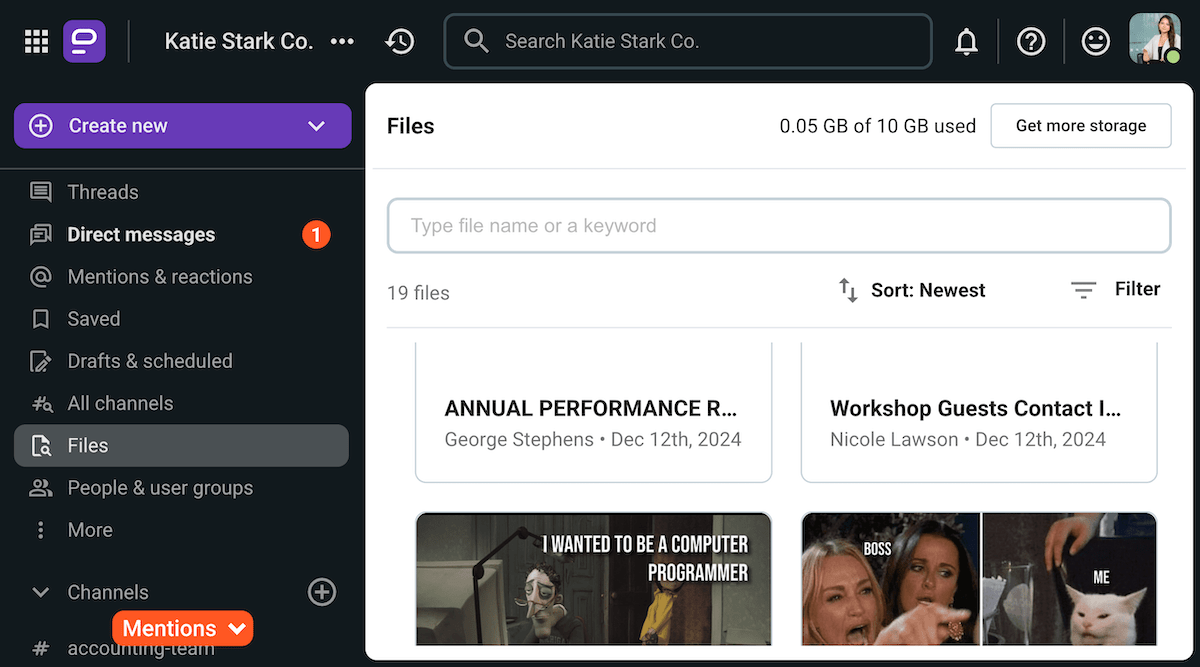
Nunca te pierdas un mensaje con Pumble
Consecuencia 3: La mala comunicación tiene un coste financiero para las empresas
Según un informe reciente de Axios HQ, que encuestó a más de mil empleados, el coste de una comunicación ineficaz en el lugar de trabajo asciende a entre $10 000 y $55 000 por empleado al año, dependiendo de su salario anual.
Básicamente, estos números destacan el hecho de que los trabajadores están pasando cientos de horas cada año respondiendo a mensajes innecesarios de colegas y clientes.
Similarmente, el informe más reciente de Grammarly mencionó que:
- El 55% de los profesionales cree que pasen demasiado tiempo escribiendo y descifrando mensajes,
- El 54% admite que considera gestionando comunicaciones laborales un desafío, y
- El 53% se siente ansioso sobre la posibilidad de malinterpretar mensajes escritos.
Además de esto, el informe de Project.co confirmó que entre los clientes que se pasaron a un competidor en 2025, el 68% informa hacerlo debido a malas habilidades de comunicación empresarial de los representantes de la empresa.
Así que, priorizar la comunicación efectiva en un nivel organizacional te puede ayudar a conservar tanto a los clientes como a los empleados.
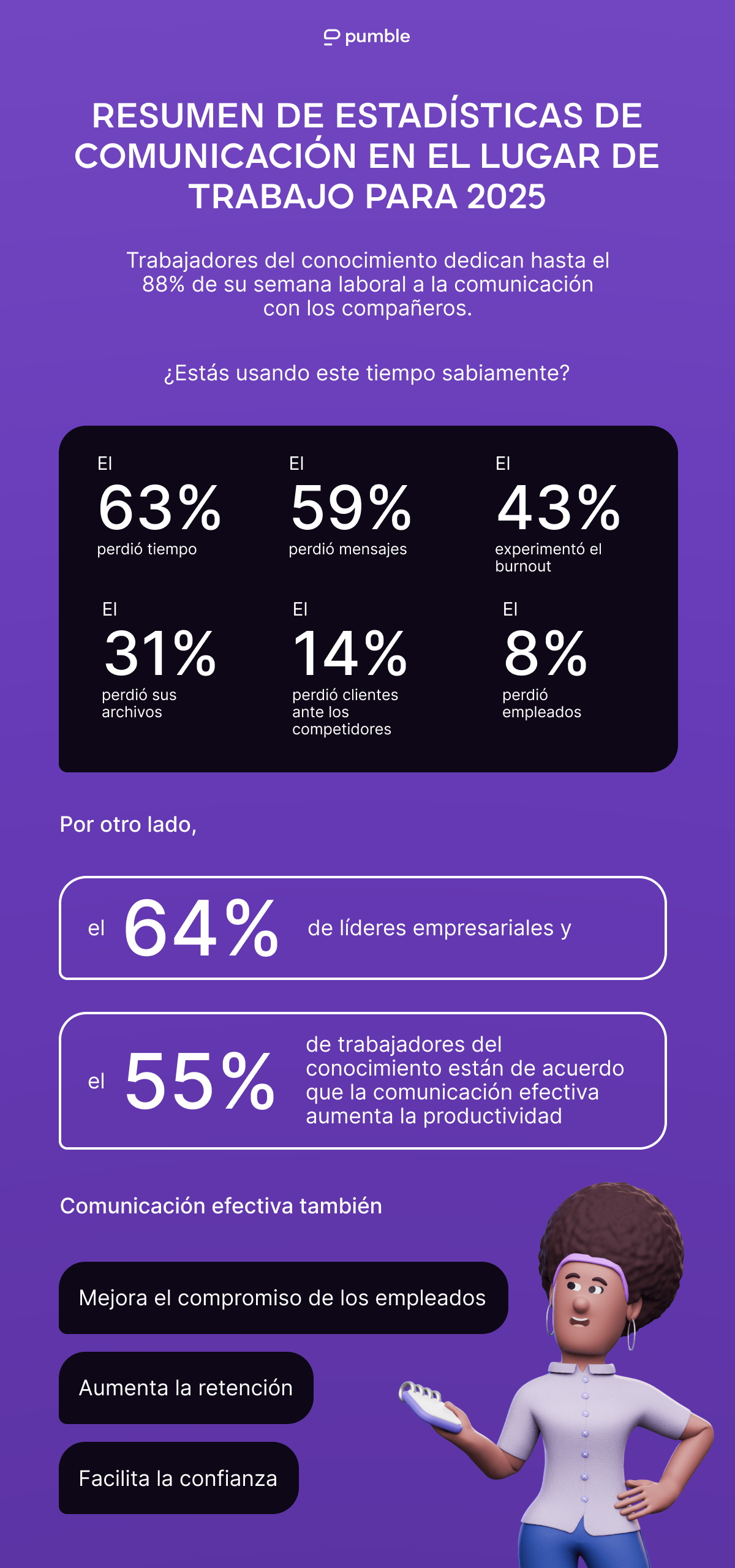
Estadísticas sobre los idiomas más utilizados en la comunicación empresarial
La comunicación verbal y escrita es uno de los tipos de comunicación más importantes en el lugar de trabajo y más allá.
Sin embargo, incluso estos tipos sencillos de comunicación pueden fracasar si los empleados de una empresa no hablan el mismo idioma.
En un mundo profesional cada vez más multicultural, hablar un idioma universal se ha convertido en una necesidad.
Afortunadamente, según el informe más reciente de Duolingo, más del 10% de usuarios de la aplicación informan haber elegido el curso de inglés para impulsar su carrera.
En efecto, el éxito profesional parece ser uno de los principales motivos para nuevos estudiantes de idiomas en 2024.
Con esto en mente, hablaremos sobre los principales idiomas que deberías añadir a tu currículum en 2025.
Idiomas comerciales para equipos internacionales
Según una encuesta de equipos virtuales, la participación en equipos globales aumentó desde el 64% en 2010 hasta el 89% en 2018, con el 62% de empleados corporativos teniendo compañeros de 3 o más culturas en 2018.
Aunque estos números están algo anticuados, muestran el valor de conocimiento de al menos 1 idioma empresarial internacional.
Sin embargo, ¿qué idioma deberías aprender si quieres tener éxito en 2025?
La siguiente tabla muestra los 10 idiomas comerciales más valiosos que se deben conocer, según el Producto Interno Bruto (PIB) del idioma en billones de dólares estadounidenses y su participación en el PIB global, según el análisis de la ONU del PIB de varios idiomas languages entre los años de 2019 y 2021. También hemos incluido la cantidad de personas que hablan estos idiomas en todo el mundo, según lo informado por Ethnologue.
| Idioma | PIB en miles de millones de $ | % del PIB mundial | Número de hablantes en todo el mundo |
|---|---|---|---|
| Inglés | 23.94 | 27 | más de 1,5 mil millones |
| Chino | 16.54 | 18 | más de 1,1 mil millones |
| Español | 6.99 | 8 | más de 559 millones |
| Japonés | 5.01 | 6 | más de 123 millones |
| Alemán | 4.91 | 5 | más de 133 millones |
| Francés | 3.44 | 4 | más de 309 millones |
| Árabe | 2.43 | 3 | más de 274 millones |
| Italiano | 2.18 | 2 | más de 67 millones |
| Portugués | 1.95 | 2 | más de 263 millones |
| Coreano | 1.86 | 2 | más de 81 millones |
Aunque el ruso y el hindi han caído por debajo del top 10, siguen siendo idiomas cruciales en el mundo profesional, junto con el holandés, el turco y el malayo-indonesio.
Curiosamente, esta lista tiene muchas coincidencias con los idiomas más estudiados en Duolingo en 2024, que incluye:
- Inglés,
- Español,
- Francés,
- Alemán,
- Japonés,
- Italiano,
- Coreano,
- Chino,
- Portugués, e
- Hindi.
Por otra parte, diferentes países tienden a priorizar otros idiomas empresariales.
¡Conecta con tu equipo internacional en Pumble!
Idiomas comerciales en los EE. UU.
Las estadísticas oficiales muestran que el 78% de la población estadounidense habla solo inglés. Pero, quizás sorprendentemente, el inglés no es el idioma oficial en los EE. UU., ya que los Estados Unidos no tienen un idioma oficial.
Según el censo de población más reciente, muchos estadounidenses también hablan:
- Español,
- Chino,
- Tagalo,
- Vietnamita y
- Árabe, entre otros idiomas.
Además, los estudiantes estadounidenses (el futuro de la fuerza laboral estadounidense) tienden a preferir el español cuando seleccionan un idioma extranjero para aprender.
Un informe reciente publicado por Modern Language Association of America comparó las matriculaciones de idiomas extranjeros en instituciones de educación superior en el otoño de 2021 con los resultados de su informe anterior, que reflejaba las matriculaciones de idiomas durante el verano y el otoño de 2016.
En última instancia, el nuevo informe encontró que la matriculación en idiomas había caído un 16,6%. Aun así, los cinco idiomas extranjeros principales para los estudiantes universitarios fueron similares a los destacados en el informe anterior:
- Español, con una participación del 49,42%,
- Francés, con una participación del 11,42%,
- Lenguaje de signos estadounidense: con una participación del 9,12%,
- Japonés, con una participación del 5,55%, y
- Alemán, con una participación del 4,52%.
El enfoque en la lengua español fue también confirmada por el más reciente informe de Duolingo. Aún así, curiosamente, el mismo informe mostró que el segundo curso más popular entre los estudiantes de idiomas basados en los EE.UU. fue el curso de inglés.
Idiomas comerciales en el Reino Unido
Según los datos del censo de 2021, el 91,1% de la población del Reino Unido habla inglés como lengua materna. Como era de esperar, el idioma oficial también es el inglés.
Aún así, además del inglés (y el galés, en Gales), la encuesta de población también mostró que la gente en el Reino Unido también habla:
- Polaco: el 1,1% de la población,
- Rumano: el 0,8% de la población,
- Punyabí: el 0,5% de la población, y
- Urdu: el 0,5% de la población.
En cuanto a los estudios de idiomas extranjeros, un informe de 2024 señaló que la mayoría de las escuelas ofrecen clases de francés, alemán y español, aunque el gobierno no promueve la enseñanza de idiomas de ninguna manera en particular. Como resultado, sólo el 32% de las personas entre 15 y 30 años en el Reino Unido afirman conocer dos o más idiomas, en comparación con el 80% de la población en los estados miembros de la UE.
En particular, este informe también menciona el informe del British Council Languages for the Future, que mostró que las personas de entre 18 y 30 años en el Reino Unido sí tenían cierto conocimiento de otros idiomas, a saber:
- Francés,
- Alemán,
- Español,
- Italiano, y
- Hindi.
El documento también enumeró los 10 idiomas empresariales internacionales más importantes aparte del inglés:
- Español,
- Mandarín,
- Francés,
- Árabe,
- Alemán,
- Italiano,
- Holandés,
- Portugués,
- Japonés, y
- Ruso.
En otras palabras, estos son los idiomas que la población del Reino Unido necesitará aprender para sobresalir en lugares de trabajo cada vez más multiculturales y multilingües.
Afortunadamente, según el informe de Duolingo, todos las señales indican que los estudiantes de idiomas basados en el Reino Unido están tomando este desafío en serio, ya que el español y francés son los cursos más populares en la aplicación dentro de este país.
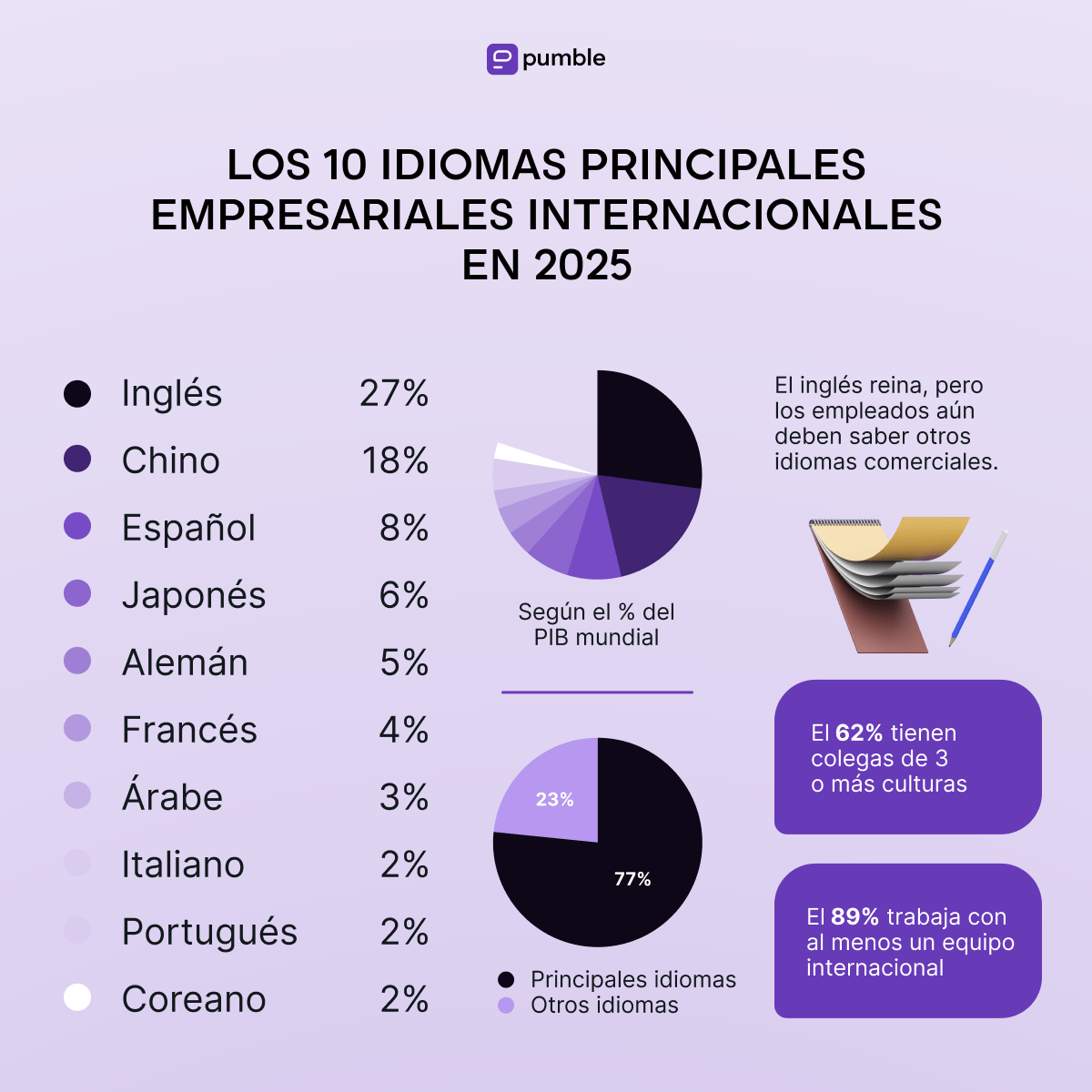
Estadísticas sobre la comunicación no verbal en el lugar de trabajo
Ahora, la comunicación verbal y escrita son sólo dos piezas del rompecabezas más amplio que constituye la comunicación humana.
Con eso en mente, queríamos centrar nuestra atención en otra pieza que es igualmente importante: la comunicación no verbal.
Como sugiere el nombre, esta forma de comunicación se trata de todos los mensajes que podemos enviar sin utilizar palabras reales.
En un entorno profesional, la comunicación no verbal puede aparecer en muchas formas, dependiendo de factores como:
- Apariencia — por ejemplo, en nuestra elección de vestimenta de negocios,
- Movimiento — por ejemplo, en los gestos que un orador principal podría utilizar para proyectar confianza,
- Expresiones faciales — por ejemplo, el ceño fruncido de un gerente cuando muestra desaprobación,
- Cualidades vocales — por ejemplo, el tono, el volumen y la inflexión de alguien que realiza una presentación,
- Posicionamiento espacial — por ejemplo, la distancia física que insinúa las actitudes de las personas entre sí,
- Toque físico — por ejemplo, como la firmeza del apretón de manos de alguien, y
- Tiempo — por ejemplo, es decir, la velocidad con la que alguien responde a un mensaje, por ejemplo.
En continuación, hablaremos sobre la importancia de esta forma de comunicación en su relación con el lugar de trabajo moderno a través de estadísticas de comunicación no verbal.
El 93% de la comunicación es no verbal - El mito de Mehrabian
Cuando surge el tema de la comunicación no verbal, la gente suele afirmar que el 93% de toda la comunicación es no verbal.
La cifra se ha mencionado en artículos científicos sobre el tema de la comunicación no verbal en el lugar de trabajo, y un autor dijo que “la comunicación no verbal representa el 93% del impacto de cualquier mensaje”
Además, la estadística se ha utilizado para resaltar la importancia de proyectar confianza durante las presentaciones comerciales.
Sin embargo, la investigación de la que surgió nunca tuvo la intención de aplicarse a ese contexto.
Por muy impresionante que parezca este posible hecho, es un concepto erróneo que ha sido desacreditado tantas veces que incluso tiene un nombre: — el Mito de Mehrabian.
El mito de Mehrabian, que lleva el nombre del psicólogo Albert Mehrabian, fue el resultado de una mala interpretación del trabajo de investigación de Mehrabian de 1967 sobre la decodificación de mensajes inconsistentes.
En el estudio, Mehrabian y su coautor, Morton Wiener, postularon que, cuando se enfrentan a mensajes inconsistentes (por ejemplo, cuando alguien dice algo que puede no ser del todo cierto), la gente suele buscar el mensaje del hablante en:
- Lenguaje corporal (y expresión facial): a una tasa del 55%, y
- Tono de voz: en un porcentaje del 38%.
En otras palabras, sólo el 7% del significado que la audiencia absorbe en casos de mensajes inconsistentes proviene de las palabras reales que el orador usó para transmitir su mensaje.
Entonces, de ahí proviene la infame estadística del 93%. En última instancia, no debe usarse fuera del contexto en el que se originó.
En cambio, deberíamos buscar estudios que aborden específicamente la comunicación no verbal en el lugar de trabajo. Pero, ¿tenemos suficientes para llegar a un consenso?
Los efectos sobre la comunicación no verbal en el lugar de trabajo
Desafortunadamente, no hay muchas investigaciones actualizadas sobre el tema de la comunicación no verbal en el lugar de trabajo. Esa omisión incluso fue mencionada en el Journal of Management en 2016, en un artículo que sugería una agenda para futuras investigaciones en este campo.
Lamentablemente, todavía faltan estudios más recientes sobre el tema.
Tomemos, por ejemplo, un estudio de 2020 sobre el impacto de las señales no verbales en la comunicación empresarial.
Los investigadores encuestaron a 150 personas (un tamaño de muestra ciertamente pequeño) y encontraron que:
- El 85% de ellos creía que el contacto visual desempeña un papel vital en la comunicación empresarial,
- El 70% dijo que las expresiones faciales (como sonreír) impactan la comunicación empresarial, aunque solo
- El 55% afirmó ser capaz de adivinar con precisión las emociones detrás de determinadas expresiones faciales.
Curiosamente, sólo el 25% de los encuestados estuvo de acuerdo con la afirmación de que la apariencia física influye en la comunicación empresarial.
Sin embargo, la principal conclusión del estudio fue que nuestros intercambios profesionales se ven afectados por factores relacionados con la comunicación no verbal, tales como:
- Falta de conocimiento de las señales faciales adaptativas (según el 75% de los encuestados),
- Los empleadores no comprenden el potencial de las señales no verbales (70%)
- Falta de formación en habilidades blandas (65%),
- Diferencias culturales (55%), y
- Falta de comunicación interpersonal (40%).
Como podemos ver, la mayoría de los participantes de la encuesta encontraron que la falta de comunicación interpersonal tiene el menor impacto en la comunicación no verbal en el lugar de trabajo. Sin embargo, debemos recordar las limitaciones de este estudio al analizar estos datos.
Barreras a la comunicación no verbal en el lugar de trabajo
Aunque los informes sobre las barreras a la comunicación no verbal son tan escasas como las estadísticas sobre cómo usamos la comunicación no verbal en el lugar de trabajo, aún hemos podido revelar algunos números interesantes.
El informe State of Hybrid Work 2024 de Owl Labs notó que tener que realizar reuniones virtuales a menudo resulta en trabajadores perdiendo el ritmo en la conversación.
Cuando se les pidió calificar la frecuencia con la que no pudieron ver las caras durante las reuniones y por lo tanto terminaron perdiendo ciertas señales visuales durante las conversaciones:
- El 13% de los trabajadores afirmó que eso ocurre siempre,
- El 23% afirmó que eso ocurre a menudo,
- El 34% afirmó que ocurre a veces, y solo
- El 30% de personas afirmó que esto nunca les había pasado.
Así que, menos de un tercio de trabajadores remotos e híbridos pueden afirmar que nunca ha tenido experiencia con esta barrera de comunicación.
Por otra parte, volver a reunirse en persona presenta un conjunto de desafíos totalmente nuevo. En primer lugar, ¿quién querría volver a la oficina después de trabajar desde casa?
Para responder a esa pregunta, echemos un vistazo a la razón por la que muchos de nosotros nos hemos acostumbrado al trabajo remoto examinando el impacto que la pandemia COVID-19 ha tenido en el mundo de la comunicación empresarial.
🎓 CONSEJO PRO DE PUMBLE
No poder ver las caras de las personas en una videollamada es un gran problema si estás intentando practicar la comunicación no verbal, pero no es la única barrera de comunicación que podrías experimentar durante la reunión. Para obtener más estadísticas sobre la comunicación en las reuniones, consulta nuestro artículo sobre las estadísticas de reuniones:
Estadísticas sobre la comunicación laboral después del COVID-19
Nos guste o no, la pandemia de COVID-19 ha tenido un impacto sustancial en el lugar de trabajo mundial.
Incluso después de que la pandemia comenzó a disminuir muchos empleados continuaron trabajando de forma totalmente remota o pasaron a un modelo de trabajo más híbrido.
Según el informe más reciente de Project.co, que encuestó a más de 350 profesionales, la mayoría de las personas aún trabaja en remoto en cierta capacidad, con:
- El 42% de respondientes de la encuesta trabajando completamente en remoto,
- El 19% pasando la misma cantidad de tiempo trabajando en remoto y en la oficina,
- El 16% trabajando completamente in situ,
- El 12% trabajando desde casa al menos ¾ del tiempo, y
- El 11% trabajando in situ ¾ del tiempo.
Sin embargo, es posible que estos números no sean completamente aplicables al público general, ya que otros informes pueden contener diferentes estadísticas. Según el informe State of Hybrid Work 2024 de Owl Labs, es posible que haya hasta:
- El 62% de las personas trabajando desde la oficina, con
- El 27% de ellas de forma híbrida, y
- El 11% de forma completamente remota.
En cualquier caso, es obvio que la pandemia ha cambiado la forma en que trabajamos y ha introducido nuevos desafíos de trabajo remoto que debemos superar.
Trabajar en remoto o volver a la oficina: los factores decisivos
Aunque la mayoría de los trabajadores ya están acostumbrados a la “nueva normalidad”, el informe más reciente de Gallup notó que trabajadores completamente remotos aún experimentan altos niveles de soledad (25%) en contraste con los trabajadores híbridos (21%) y aquellos que trabajan exclusivamente in situ (16%).
Además, los trabajadores remotos tienden a sentirse más tristes a menudo, con el 29% experimentando tristeza el día anterior a la encuesta, a diferencia del 21% de los trabajadores híbridos y el 19% de los trabajadores in situ.
Aún así, esto no parece afectar mucho la comunicación, al menos según los números del informe de Communication Statistics 2025 , que muestra que:
- El 53% de personas no encuentra la comunicación más o menos desafiante que en 2024,
- El 24% de personas encuentran la comunicación menos desafiante que el año pasado, y
- El 23% la encuentra más desafiante de lo que solía ser.
Por lo tanto, la mayoría de las personas no se dejarán tentar por la oficina con la promesa de una mejor comunicación.
Sin embargo, según el informe de Owl Labs, la promesa de una mayor compensación podría funcionar, según el 41% de los empleados.
El informe también destaca otros problemas que podrían influir en la decisión de los empleados de volverse a la oficina:
- El tiempo (28%) y los costes (26%) del viaje,
- Los costes de comida y bebida (26%),
- Preocupación por la privacidad y código de vestimenta (23%),
- Mejor tecnología de las salas de reuniones (18%), y
- La oportunidad de ver a los compañeros de trabajo (17%) y tener eventos sociales en la oficina (16%) como factores decisivos.
Como lo indican los dos últimos puntos anteriores, algunas personas no sienten que las herramientas de la comunicación asíncrona proporcionadas por su organización sean efectivas en proporcionar una experiencia satisfactoria para la comunicación en tiempo real.
Elegir una plataforma de comunicación empresarial poderosa y fácil de usar como Pumble puede mejorar la comunicación de trabajo desde casa y en la oficina mientras cerrando la brecha entre los trabajadores remotos y en situ.
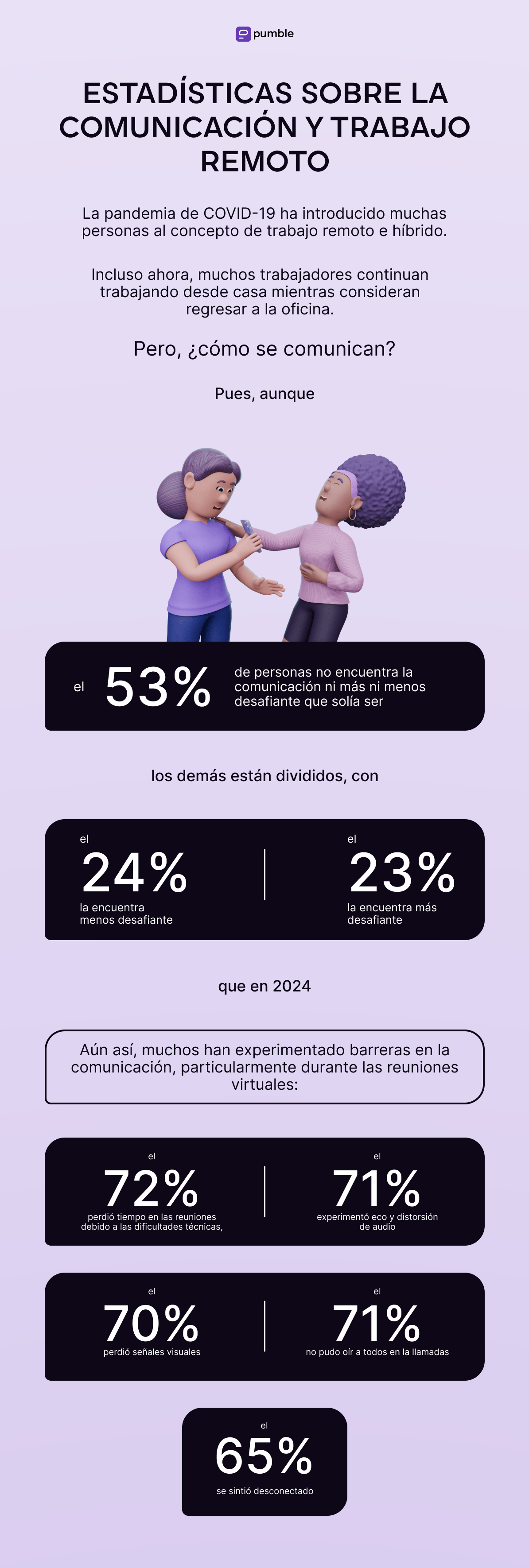
Estadísticas sobre cómo la gente prefiere comunicarse en el lugar de trabajo
Las preferencias de comunicación en el lugar de trabajo dependen de si eres un gerente o un empleado regular.
Veamos si las expectativas de los gerentes y empleados se alinean en lo que respecta a lo que quieren obtener de la comunicación en el lugar de trabajo.
Las estadísticas de comunicación sobre las habilidades de comunicación más deseables en los solicitantes de empleo
Según el último informe de GMAC Corporate Recruiters, el 57% de los empleadores globales indica que la comunicación es la habilidad más deseable en los potenciales reclutas.
Esta fuente de las estadísticas de habilidades de comunicación también incluyó otras habilidades relacionadas, impulsadas por:
- El 50% de los empleadores que priorizan interpersonales/habilidades de trabajo en equipo,
- El 42% de los empleadores que destacaron la inteligencia emocional,
- El 37% de los empleadores que denominaron el networking y el desarrollo de relaciones una habilidad valiosa, y
- El 29% de los empleadores que mencionaron la competencia multicultural o inteligencia cultural como una ventaja.
Los mismos respondientes de la encuesta calificaron diferentes habilidades de comunicación según importancia, resultando en la siguiente lista:
- El 55% de los empleadores priorizaron las habilidades de comunicación verbal,
- El 47% priorizó las habilidades de presentación,
- El 36% mencionó la escucha activa,
- El 31% vvaloró los candidatos con las habilidades de comunicación digital (la habilidad de comunicar efectivamente a través del correo electrónico o un software de comunicación interna),
- El 30% apreció los candidatos que podrían negociar,
- El 25% buscó candidatos con excelentes habilidades de escritura,
- El 24% mencionó la resolución de conflictos, y
- El 20% destacó la comunicación multicultural.
En general, las habilidades de comunicación menos valoradas entre los empleadores fueron:
- Multilingüismo, que solo el 10% de respondientes valoraron,
- Habilidades de videoconferencias (9%), e interesantemente,
- Habilidades de comunicación no verbal (8%).
Aún así, las habilidades exactas que los empleadores valoran dependen en gran medida de la industria en la que uno quiere entrar, así que ten esto en cuenta antes de empezar a abandonar tus estudios de idioma.
La estadísticas de comunicación sobre el propósito de comunicación interna en el lugar de trabajo
Según el último informe State of the Sector 2024, el 84% de los empleados dependen de sus gerentes para comunicarse hasta cierto punto.
Como tales, los gerentes o “comunicadores”, como los define este informe, son responsables de:
- Desempeño de los empleados — según el 74% de los encuestados,
- Conciencia de la estrategia — según el 70% de los encuestados,
- Cambio de comportamiento — según el 49% de las personas,
- Alcance digital — según el 46 % de los encuestados, y
- Cumplimiento de políticas — según el 34% de las personas.
Pero, ¿cuál ven los gerentes como el propósito de la comunicación interna?
Pues, el 78% de ellos estaría de acuerdo que su prioridad son la cultura y la pertenencia, mientras que el 76% dijo que el propósito de la comunicación interna es la alineación estratégica.
Pero, si la alineación es el objetivo, el liderazgo puede estar fuera de lugar.
Según el último informe de Axios HQ, las percepciones de la claridad y la importancia de comunicación esencial varió entre el liderazgo y los empleados, con:
- El 85% de los líderes afirmando que la comunicación esencial en su organización es útil e importante, que fue apoyado por solo el 45% de los empleados, y
- El 83% de los líderes afirmando que esta comunicación fue también clara y atractiva, pero solo el 47% de los empleados estuvo de acuerdo.
Además, el informe también mostró quela mayoría de los empleados prefiere recibir noticias sobre :
- Cambios operacionales sobre actualizaciones de procesos y políticas,
- Objetivos organizacionales como una nueva iniciativa y plan,
- Operaciones de personal como beneficios o iniciativas DEI,
- Cultura y valores,
- Actualizaciones empresariales sobre proyectos, productos y clientes,
- Actualizaciones personales sobre nuevos empleados o despedidas,
- Información competitiva y noticias de la industria, y
- Actualizaciones globales.
Aún así, estos empleados recibían noticias con mayor frecuencia sobre temas que les interesaban menos, es decir, las noticias de la industria y actualizaciones globales.
🎓 CONSEJO PRO DE PUMBLE
Si te resulta difícil redactar mensajes para la comunicación interna, consulta los siguientes recursos:
Las estadísticas de comunicación sobre la importancia de recopilar el feedback de los empleados
Una de las formas en que las empresas pueden promover internamente la comunicación bidireccional es proporcionando y solicitando el feedback. Sin embargo, puede que sea más fácil decirlo que hacerlo.
Según el informe State of the Sector 2024, las maneras más comunes de recopilar el feedback de los empleados son:
- Encuestas de compromiso (75%),
- Feedback después de un evento (54%),
- Preguntas frecuentes en vivo sessions (52%),
- Correos electrónicos (48%), y
- Encuestas de pulso (47%).
Por otra parte, el informe de Axios HQ mostró que los líderes tienden seguir la comunicación interna principalmente a través de:
- Encuestas de empleados (41%),
- Feedback no solicitado de los empleados (39%), y
- Rendimiento empresarial general (39%).
Es interesante, el 22% de los líderes también dijo que utilizan reacciones de emoji y comentarios para seguir su comunicación interna, así que ten esto en cuenta la próxima vez que reacciones a un anuncio de la empresa.
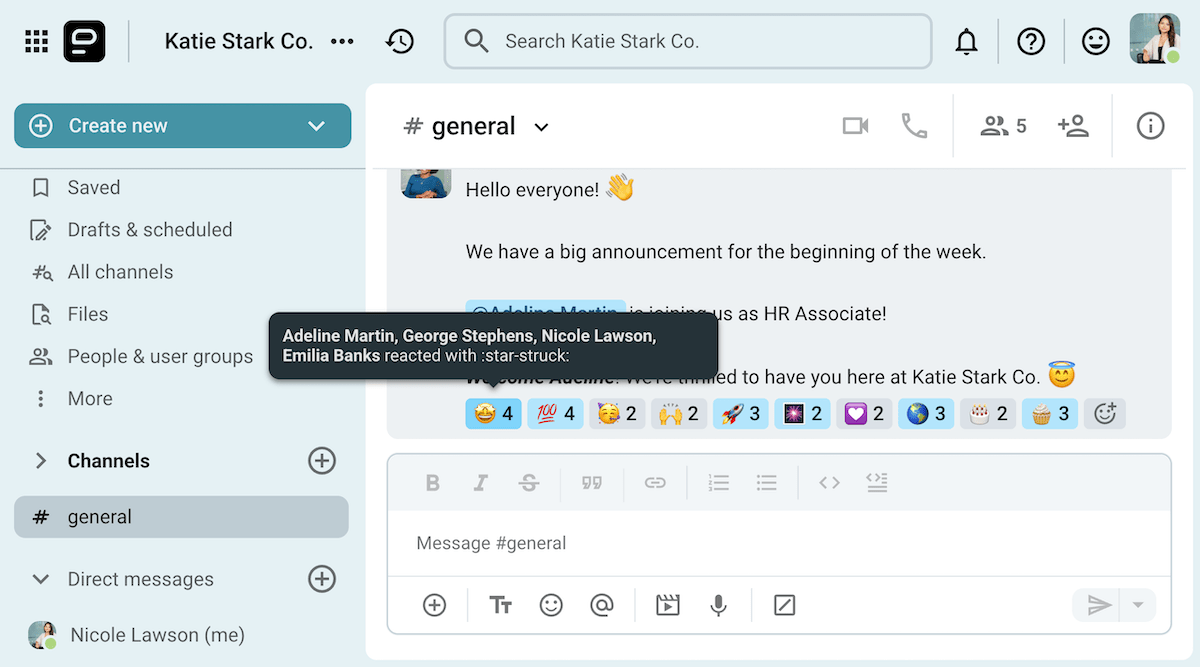
Comparte feedback sin problemas a través de Pumble
A pesar de todo este aparente deseo de recibir el feedback de los empleados, el informe de Axios HQ también indicó que incluso:
- El 81% de los líderes creen que sus empleados tienen una manera fácil de compartir el feedback sobre la comunicación interna, y solo
- El 44% de los empleados están de acuerdo.
De hecho, el 36% de los empleados desean más oportunidades para proporcionar el feedback a los líderes.
Sin embargo, incluso si las organizaciones abren estos canales de comunicación ascendente, saber cómo aceptar y aplicar el feedback en cuestión todavía sería un problema.
Después de todo, según el informe de Archivers Workforce Institute sobre el compromiso y la retención de los empleados, las personas que dicen que sus empleadores toman acciones significativas según su feedback tienen un 75% más de probabilidades de confiar en el liderazgo de su empresa que aquellos cuyos líderes recopilan el feedback pero no actúan en consecuencia.
🎓 CONSEJO PRO DE PUMBLE
Feedback es una oportunidad de mejorar. Para aprender más, consulta el siguiente artículo:
Las estadísticas de comunicación sobre el efecto de reconocimiento de los empleados en el compromiso, la productividad y la retención
En la otra cara de la moneda del feedback, no debería sorprendernos saber que a los empleados también les gusta que se les reconozca por sus contribuciones a la empresa.
De hecho, las personas que nunca son reconocidas tienen un 27% más de probabilidades que el promedio de buscar otros trabajos en 2024, según el Informe de participación y retención para 2024.
El mismo informe también encontró que la frecuencia del reconocimiento que reciben los empleados los hace más comprometidos y productivos, además de ser más propensos a decir que rara vez piensan en buscar otras oportunidades laborales, como se muestra en la siguiente tabla.
| Frecuencia de reconocimiento | Reconocimiento anual (o menos frecuente) | Reconocimiento trimestral | Reconocimiento mensual (o más frecuente) |
|---|---|---|---|
| Compromiso | 27% | 34% | 51% |
| Retención | 18% | 23% | 35% |
| Productividad | 10% | 17% | 25% |
Sin embargo, el informe también señaló que solo el 6% de los empleados mencionaron el reconocimiento (o la falta del mismo) como una razón para dejar su empresa en 2024. Además de eso, solo el 9% de las personas citaron el reconocimiento como su razón para quedarse.
El año pasado, la compensación parece ser el mayor problema para la retención de empleados, ya que el 28% de los empleados afirmaron que la compensación fue su razón para dejar un trabajo, seguido por la falta de oportunidades de progresión profesional en el 24% (lo que, posiblemente, está relacionado con el reconocimiento), y la flexibilidad laboral, con un 23%.
Las estadísticas de comunicación sobre las barreras a la comunicación en el lugar de trabajo
Según el último informe State of the Sector, los comunicadores deben superar numerosos obstáculos para llevar su organización al éxito.
Las barreras causadas por las malas prácticas de comunicación, incluyen específicamente:
- Tecnología/canales internos no adecuados (según el 24% de respondientes),
- Alto volumen de comunicación (19%),
- Habilidades de comunicación deficientes de los gerentes de personal (18%),
- Falta de dirección desde la alta dirección (17%), y
- Falta de aviso previo para anuncios organizacionales (13%).
Algunas de estas preocupaciones, como el alto nivel de comunicación, se reflejaron en el informe de Grammarly, que mostró que los trabajadores del conocimiento dedican hasta el 88% de su semana laboral comunicándose en varios canales.
De hecho, muchos de estos canales de comunicación están facilitados por soluciones tecnológicas, que contribuyen a algunas barreras de comunicación en el lugar de trabajo.
Como hemos mencionado anteriormente, el informe de Owl Labs mostró que el 70% de personas informó pasar por alto las señales visuales durante las reuniones virtuales con cierto grado de frecuencia (esto es el resumen de personas que respondieron a la pregunta con “siempre”, “a menudo” y “a veces”).
Además de esto, un total del:
- 72% de personas informó perder tiempo en reuniones debido a dificultades técnicas,
- 71% informó oír eco y distorsión del audio durante las reuniones virtuales,
- 70% experimentó no poder oír a todos en la llamada,
- 65% se sintió desconectado durante las reuniones,
- 64% tuvo dificultades contribuir a la conversación, y
- 61% informó no poder ver la presentación en la pantalla compartida.
Aunque utilizar una aplicación de videoconferencias confiable puede eliminar algunas de estas preocupaciones, algunas barreras permanecerán insuperables debido a factores como la conectividad al internet y el suministro eléctrico.

Organiza reuniones efectivas en Pumble
Las estadísticas de comunicación sobre el papel de la tecnología en la comunicación en el lugar de trabajo
Como ya hemos establecido, la transición a los modelos de trabajo remotos e híbridos ha llevado a muchas empresas a incorporar las soluciones digitales en sus estrategias de comunicación.
Aunque se informa que el correo electrónico sigue siendo la herramienta más utilizada en la comunicación con los clientes (a una tasa del 57%, según las Estadísticas de comunicación para 2025) y los compañeros de trabajo (36%) igualmente las herramientas de comunicación en equipo en línea como Pumble se encuentran justo detrás de él, con:
- El 10% de personas usándolas en la comunicación externa con clientes (aunque el 15% de personas en realidad utilizó herramientas de gestión de proyectos para comunicarse con clientes), y
- El 26% de personas usándolas en comunicación interna (con herramientas de gestión de proyectos siguiendo de cerca a la tasa de 17%).
Aún así, según el último informe de Grammarly, el 66% de los trabajadores del conocimiento y el 72% de los líderes empresariales desean que sus empresas les proporcionen mejores herramientas de comunicación.
Teniendo esto en cuenta, veamos el futuro de la comunicación en el lugar de trabajo y examinemos qué otras tecnologías podríamos incorporar en nuestros entornos profesionales.
Las estadísticas de comunicación sobre el uso de la IA generativa en el trabajo
En 2025, una gran parte de la conversación sobre las nuevas tecnologías se centra en la inteligencia artificial y cómo cambiará la comunicación en el lugar de trabajo al:
- Facilitar la escritura,
- Acortar el tiempo de producción,
- Aumentar la producción, y
- Reducir los costes de formación.
Gracias al nuevo informe de Grammarly, sabemos que el 89% de los líderes y el 52% de los trabajadores del conocimiento ya usan las herramientas de IA generativa.
En general, los trabajadores creen que el uso de IA:
- Ha reducido sus niveles de estrés (según el 46% de los respondientes),
- Ha aumentado su productividad (44%),
- Ha reducido su carga de trabajo (44%),
- Ha aumentado su satisfacción con el trabajo (43%), e incluso
- Ha mejorado su creatividad (39%).
Más de una mitad de los trabajadores del conocimiento (56%) ahora no puede imaginar haciendo sus tareas de trabajo sin ayuda de la IA generativa, dado que usarla también les:
- Ha mejorado su calidad de trabajo (80%),
- Ha ayudado a evitar la falta de comunicación en el trabajo (73%),
- Ha transformado la manera en que se comunican en el trabajo (71%), y
- Ha ayudado a comunicarse más efectivamente con los compañeros de trabajo (68%).
Por otra parte, los líderes han notado que las herramientas de IA generativa:
- Han aumentado la eficiencia (52%),
- Han impulsado la productividad (50%),
- Han mejorado la calidad de los servicios en sus equipos (45%),
- Han acelerado la innovación (43%), e incluso
- Han ahorrado los costes (38%).
Sin embargo, muchos líderes comerciales todavía están preocupados por ciertos aspectos de herramientas de IA generativa, en particular:
- Seguridad (65%),
- Privacidad (64%),
- Control de calidad (63%),
- Propiedad intelectual (61%), y
- Copyright (60%).
Aún así, incluso los reclutadores han notado que las habilidades de IA y aprendizaje automático son entre las habilidades más importantes que los candidatos de trabajo deberían tener, con el 26% de ellos destacando su valor en el informe de GMAC Corporate Recruiters.
Como puedes imaginar, esto proporciona una ventaja a los profesionales más jóvenes a quienes les ha resultado más fácil incorporar las herramientas de IA generativa en sus procesos de trabajo.
Las estadísticas de comunicación en lugares de trabajo multigeneracionales
Comprender la forma en que se comunican las diferentes generaciones puede ayudarte a crear una fuerza laboral más unificada.
Tal como están las cosas, los profesionales más jóvenes reportan niveles más altos de insatisfacción con las prácticas de comunicación de sus organizaciones según el informe de Grammarly para 2023.
También es más probable que experimenten problemas de comunicación escrita semanalmente:
- El 60% de la Generación Z y los Millennials reportan problemas de comunicación, pero solo
- El 40% de los trabajadores de la Generación X, y
- El 30% de los Baby Boomers hacen lo mismo.
Incluso en el informe más reciente de Grammarly, los profesionales más jóvenes experimentan problemas de comunicación.
Aunque los Millennials pasan más de la mitad de su semana laboral comprometidos en la comunicación escrita, los trabajadores de Generación Z:
- Pasan demasiado tiempo intentando de transmitir su mensaje de correcta manera (según el 70% de los encuestados de la Generación Z),
- Pasan demasiado tiempo reescribiendo las conversaciones (65%), y
- Se sienten inseguros sobre el canal adecuado para comunicar la información (58%).
Sin embargo, estos dos grupos son también aquellos que se están beneficiando al máximo del uso de las herramientas de IA generativa:
- El 61% de los trabajadores de Generación Z no pueden imaginar trabajar sin las herramientas de IA generativa, en comparación con:
- El 56% de los Millennials,
- El 53% de los trabajadores de la Generación X, y
- El 41% de los Baby Boomers.
Como era de esperar, los Baby Boomers han sido los más lentos en adoptar la tendencia, el 69% admitiendo que no saben cómo usar la IA generativa, en contraste con el 47% de los Millennials.
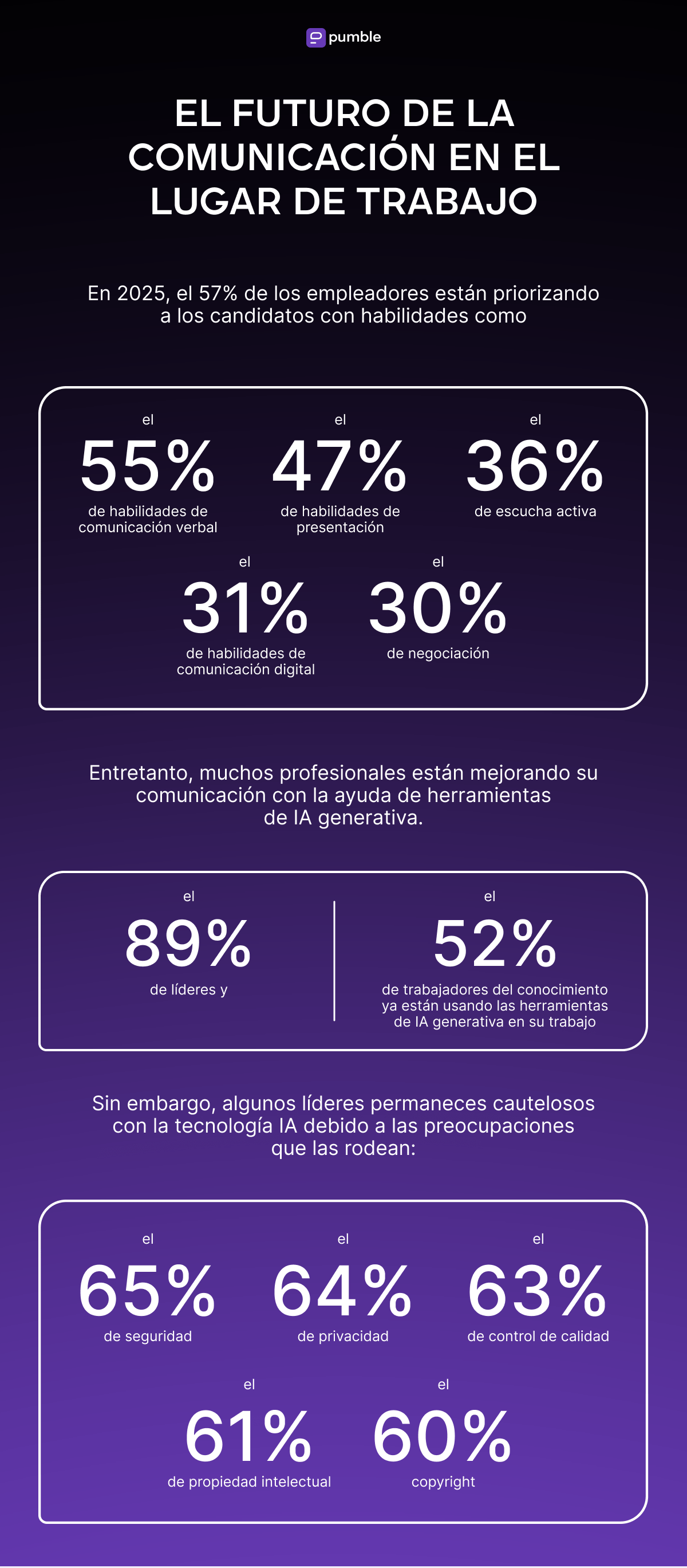
Estadísticas sobre las plataformas de comunicación que utilizan las personas en el lugar de trabajo
Como se notó anteriormente, el correo electrónico sigue siendo la plataforma más utilizada para la comunicación empresarial en 2025.
Sin embargo, según el informe Communication Statistics 2025, las herramientas de chat en línea siguen siendo la segunda plataforma más popular para intercambiar la comunicación relacionada con el trabajo.
| Comunicación interna | Comunicación externa | |
|---|---|---|
| Correo electrónico | 36% | 57% |
| Herramientas de chat en línea | 26% | 10% |
| Herramientas de gestión de proyectos | 17% | 15% |
| Otro | 9% | 6% |
| Llamadas por teléfono | 6% | 9% |
| Interacciones cara a cara | 6% | 2% |
El hecho de que las reuniones ocupen el último lugar de esta lista tiene sentido, ya que el 61% de los respondientes siente que son una pérdida de tiempo.
Sin embargo, el informe más reciente de Grammarly muestra una imagen diferente en cuanto a las horas promedio que los trabajadores pasan comunicándose en varios canales:
- Reuniones en vídeo, teléfono y en persona ocuparon 10,45 horas de la semana laboral promedia de los trabajadores,
- Correos electrónicos ocuparon 5,94 horas a la semana,
- Chat de texto ocupó 3,89 horas,
- Intercambio de documentos ocupó 3,33 horas,
- Mensajes de texto ocuparon 3,28 horas,
- Aplicaciones de gestión de proyectos ocuparon 2,46 horas,
- Pizarras blancas ocuparon 1,81 horas, y
- Herramientas de gestión de conocimiento ocuparon 1,70 horas.
Sea cual sea el caso, la dominación de los correos electrónicos en la comunicación externa tiene sentido cuando tomamos en consideración que las herramientas de mensajería en línea habitualmente se utilizan solo para la comunicación interna.
Sin embargo, muchas aplicaciones de mensajería ahora ofrecen opciones de cuenta de invitados, lo que puede aumentar su uso en la comunicación con clientes y colaboradores externos.
🎓 CONSEJO PRO DE PUMBLE
Aunque los correos electrónicos representan la mayor parte de todas las comunicaciones comerciales, no son la plataforma ideal para esos intercambios. Descubre por qué aquí:
Estadísticas sobre uso y eficacia de los canales de comunicación en el lugar de trabajo
El informe más reciente de State of the Sector analizó los diversos canales de comunicación que podemos utilizar en el lugar de trabajo, así como su eficacia.
Los siguientes fueron 5 de los canales más utilizados aplicados cuando el empleador deseaba compartir información con la organización en general:
- Los correos electrónicos se utilizaron a una tasa del 92% y se consideró que tenían una efectividad del 89%,
- Los eventos en vivo para todos los empleados se utilizaron el 78% del tiempo con una efectividad del 97%,
- Los boletines informativos electrónicos se utilizaron el 71% del tiempo con una efectividad del 87%,
- Los eventos en vivo de líderes se utilizaron el 63% del tiempo con una efectividad del 98%, y
- Los vídeos se utilizaron el 59% de las veces con una efectividad del 85%.
En cuanto a los otros canales enumerados en el informe, las conferencias telefónicas para líderes y todos los empleados también demostraron tener una efectividad superior al 96%.
El informe más reciente de Axios HQ también incluyó un resumen de canales utilizados por los empleadores para la comunicación interna así como la tarifa de preferencia de los empleados por cada solución.
Es decir, los líderes tienden a gravitar hacia:
- Reuniones de todo el personal o departamentales (según el 36% de líderes encuestados),
- Aplicaciones de empleados (34%),
- Herramientas de chat o mensajería instantánea (33%),
- Llamadas telefónicas (33%),
- Correo electrónico ad hoc (32%),
- Mensajes de texto (30%),
- Mensajes de vídeo (27%),
- Boletines informativos/actualizaciones recurrentes (24%),
- Intranet (24%),
- Señalizaciones físicas o digitales (23%), y
- Podcasts (20%).
De estos, los podcasts tuvieron el índice de aprobación más bajo entre los empleados (4%), mientras que las reuniones fueron la manera más preferida de comunicarse internamente (36%).
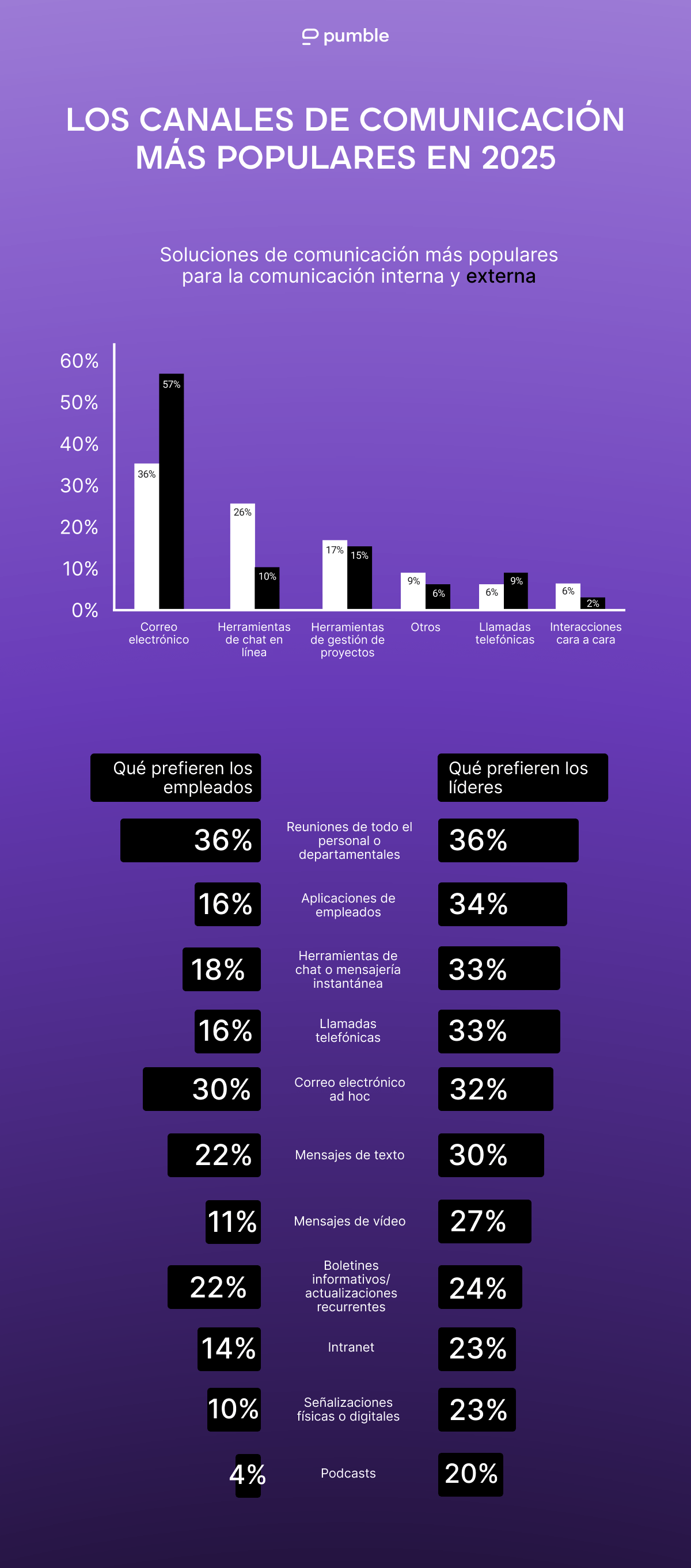
Mejora los resultados de comunicación en tu lugar de trabajo con Pumble
A medida que los lugares de trabajo pasan de las oficinas a los entornos en línea, la comunicación efectiva se vuelve más importante que nunca, lo que aumenta la necesidad de herramientas digitales efectivas y una capacitación adecuada.
Sin embargo, como aprendimos del informe State of the Sector 2024, un tercio de los encuestados no están satisfechos con los canales de comunicación que utilizan para llevar a cabo la comunicación en el lugar de trabajo.
Incluso el informe más reciente de Grammarly muestra que tanto los líderes empresariales como los trabajadores del conocimiento quieren mejores herramientas de comunicación.
Entonces, ¡dale a la gente lo que quiere!
Si tus empleados tienen dificultades para mantener una comunicación efectiva interna o externa, ¡prueba Pumble, la aplicación de comunicación de empleados!
- Organiza tus conversaciones con mensajes directos, hilos, y canales.
- Utiliza roles y permisos para limitar el acceso a información confidencial.
- Envía mensajes de voz y vídeo o realiza videollamadas con todo el equipo y haz que tus clientes se unan dándoles acceso de invitados.
Aprovecha al máximo la comunicación en tu lugar de trabajo.
Cómo revisamos esta publicación: Nuestros escritores y editores monitorean las publicaciones y las actualizan cuando hay nueva información disponible, para mantenerlas frescas y relevantes.


